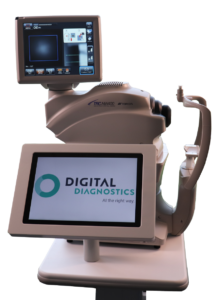
Digital Diagnostics believes this historic decision will help improve patient outcomes and expand access to healthcare through the reimbursement of autonomous AI
Innovation is hard; getting paid for innovation—even harder.
It’s one thing to create (or iterate on) something that demonstrates value. It’s another to convince someone to use that innovation and receive some level of payment from them. Building something that is demonstrably valuable and then managing the ins and outs of the healthcare ecosystem so that your customers (who are health care providers) can recoup what they pay for it…now we’re talking!

LumineticsCore™ (formerly known as IDx-DR) is an autonomous AI that was developed according to our ethical framework and an understanding of the need for introducing safe and unbiased AI into patient care. The technology was designed to enable a computer to make a medical decision instead of the provider—the first ever of its kind. In 2018, LumineticsCore (formerly known as IDx-DR) was De Novo cleared by FDA to provide a diagnostic result for patients with diabetes who are at risk for diabetic retinopathy (including macular edema).
Shortly following FDA de novo clearance were a bevy of phone calls from prospective customers (mostly providers) wanting to pilot the technology for the betterment of their patients. During those calls important questions were asked—most often about workflow, Electronic Health Record (EHR) integration, quality measure (HEDIS/MIPS/STARS) qualification, and ultimately, “will I be paid for spending time and resources on this”?
Foundational to the way healthcare has worked for decades is the notion that every minute counts, and that time spent on any activity must bear fruit…financial fruit. There’s a debate to be had about how we pay for healthcare and the oft-used “value-based care”, and the differentiation between a fee-for-service world and a fee-for-value world—we understand that. Furthermore, we could also talk about the Medicare Trust Fund becoming insolvent in the very near future …. but that’s for another time. The truth is that for the foreseeable future, getting paid for spending time on something still really matters, and that brings us back to where we began… payment.
From the time FDA cleared LumineticsCore (formerly known as IDx-DR) in 2018, until the final ruling by Centers for Medicare and Medicaid Services (CMS) on November 2, 2021, payment still seemed elusive. It’s important to note that throughout this time, the AAFP, AMA, the AAO, ADA, NMHA and the NCQA, to name a few, stood together in support of doing AI the right way.
Customers all over the United States have seen the value of the innovation to patients needing access yet have been hesitant to invest their time or resources given this is a first of its kind technology paving a new pathway in healthcare. This is not the incentive alignment we want (and need) to enable patients to get access to responsible and routine testing.
The COVID-19 pandemic highlighted disparities in community health and exacerbated resource constraints facing healthcare providers and the physician community. Reimbursement policies can make the difference between opting to provide innovations such as LumineticsCore (formerly known as IDx-DR) at the point-of-care or continuing to address diabetes care with referrals and follow up. While payment rates may vary by the multitude of healthcare payors in the United States, Medicare policies can set the standard for reimbursement and spur future health technology innovation more broadly.
As previously referenced, exciting news came one bright and sunny day when CMS finalized its fee schedules for Calendar Year 2022. In the final ruling, CMS made clear (in our view at least) that they understand that innovation is hard. Even more so, they made clear that taking the time to work within an ethical framework, then rigorously validating your AI, is worth it. In their final regulation, CMS finalized national payment for CPT® 92229, Imaging of retina for detection or monitoring of disease; with point-of-care automated analysis with diagnostic report; unilateral or bilateral.
What does all this mean?
First and foremost, it means access. Many have talked about meaningfully changing access in healthcare; we believe we’re actually moving the needle. As Covid-19 has highlighted, there are healthcare deserts everywhere, and access is not universal. With LumineticsCore (formerly known as IDx-DR) we now have a system that can be plugged in anywhere and enables a point-of-care diagnostic result. Those willing to bring it into their practice will get paid for taking a few minutes to prevent their patients from going blind. That’s pretty great and is central to our mission.
The agency recognized the benefit that “emerging and evolving technologies” could have as a way to increase “access to care for Medicare beneficiaries, improve outcomes and reduce overall costs to the program.” By recognizing that practitioners incur resource costs for use of the system, patients can have equal access to the technology. The national Medicare rate will benefit provider and patient access to vision-saving technologies. Whether a person lives in far reaching areas of Alaska or in New York City will no longer determine access to the LumineticsCore (formerly known as IDx-DR) service.
This seems like the right time to mention liability.
For all those innovating around AI, it’s worth noting that autonomous AI (where the creator of that AI assumes liability) gets paid at a sustainable level. Autonomous AI significantly creates value, and our overburdened health system needs more innovators willing to assume liability for what they build.
CMS deciding to pay for LumineticsCore (formerly known as IDx-DR) demonstrates an open mind toward supporting future innovation in the healthcare autonomous AI space. Using our ethical framework, we navigated each of these hurdles in alignment with all healthcare stakeholders to solve for the many issues the industry previously faced. We had many companies reaching out–some much bigger than we are, some much smaller. Size notwithstanding, the consistent thread from these companies (all working with AI in some capacity) centered around one gap—payment. They wanted to know where to invest their precious time, money, and human capital resources as they built their companies. They have read the most recent HBR articles and tapped their VC friends for advice and counsel around business model innovation. They have talked with their boards about which path makes the most sense for them. They have done peer-networking or have spent time in popular incubator environments to get differing viewpoints and guidance. Ultimately though, they want to know when they create real value, will it be paid for, and if the answer is yes, how will that work?
Increasingly, CMS plays a central role in this process given their number of growing beneficiaries, their close tie to many of the commercial health plans, and how they set medical policy for coverage and payment. While the road is still long and winding, we are encouraged by the support for rigorously validated and FDA cleared autonomous AI in healthcare that improves patient access and reduces unnecessary healthcare spend. In the meantime, serious kudos to CMS (among many others) for the comprehensive review and patient-first approach to supporting autonomous AI in healthcare. The decision by CMS to create national payment is truly historic!